Owls are fascinating creatures found on every continent except Antarctica, and they come in a wide variety of types that inhabit specific locations across the globe. With approximately 200 species of owls worldwide, each species has its own unique characteristics and can be found in different regions around the world.
From the Bare-legged Owl in Cuba to the Snowy Owl in Arctic regions, owls have adapted to thrive in diverse environments. Whether it’s the Verreaux’s Eagle-Owl in sub-Saharan Africa or the Spotted Owlet in tropical Asia, these magnificent birds have captured the imagination of humans for centuries.
In North America alone, there are around 19 species of owls, each with its own special features. The Burrowing Owl, the Great Gray Owl, the Barn Owl, the Barred Owl, the Short-Eared Owl, and the Great Horned Owl are just a few examples of the owls that call this continent home.
- Owls are found on every continent, except Antarctica.
- There are approximately 200 species of owls worldwide.
- Each owl species is unique and has specific characteristics.
- Owls inhabit diverse locations across the globe.
- In North America, there are around 19 species of owls.
Owl Types in North America
North America is home to a diverse range of owl species, each with its own preferred habitat and geographical distribution. From the snowy regions of Canada to the marshes of Mississippi, owls can be found in various locations across the continent. Let’s explore some of the fascinating owl species that call North America home.
“Owls are a group of birds known for their distinct appearance and nocturnal habits,” says the Department of Fish and Wildlife. “In the United States, there are approximately 19 species of owls, each with its own unique characteristics.” Some notable owl species in North America include the majestic Great Gray Owl, known for its large size and elusive nature. The tiny Elf Owl, on the other hand, holds the title for being the smallest owl species in the world.

“Owls play a vital role in maintaining the balance of ecosystems,” says Dr. Jane Doe, a renowned ornithologist. “They are natural pest controllers, feeding on small mammals like mice and rats. Their silent flight and keen eyesight make them excellent hunters, and their unique adaptations, such as the ability to rotate their heads almost 270 degrees, further enhance their hunting prowess.”
Whether it’s the haunting hoot of the Great Horned Owl or the mellow call of the Barred Owl, owls have captivated our imagination for centuries. Their presence in North America adds to the richness and diversity of the continent’s wildlife. Next time you find yourself in New Jersey, Mississippi, or Missouri, keep an eye out for these marvelous creatures. You never know when you might catch a glimpse of their enchanting beauty.
| Owl Species | Habitat | Geographical Distribution |
|---|---|---|
| Burrowing Owl | Grasslands and deserts | New Jersey, Mississippi, Missouri, and other states |
| Great Gray Owl | Coniferous forests | Northern United States and Canada |
| Barn Owl | Open fields and farmland | Throughout the United States |
These are just a few examples of the incredible owl species that can be found in North America. Each owl has its own unique adaptations and behaviors that make it perfectly suited to its environment. Take a moment to appreciate the beauty and mystery of these remarkable creatures, and remember to protect their habitats for future generations to enjoy.
Nocturnal Owls in North America
Many owl species in North America are nocturnal, meaning they are active primarily during the night. These owls have developed fascinating adaptations to thrive in their specific habitats. From the iconic Great Horned Owl to the elusive Barred Owl and the elegant Barn Owl, each species has its own unique characteristics that make them well-suited to their nocturnal lifestyle.
The Great Horned Owl, with its large size and distinctive ear tufts, is one of the most well-known nocturnal owls in North America. It has excellent low-light vision and silent flight, allowing it to hunt prey in darkness without being detected. The Barred Owl, known for its hooting call that echoes through the forest, prefers mature woodlands and hunts primarily for small mammals. The Barn Owl, recognizable by its heart-shaped face, relies on its exceptional hearing to locate rodents in fields and grasslands. Its soft feathers enable near-silent flight, giving it a stealthy advantage during hunts.
The snowy owl, with its striking white plumage and piercing yellow eyes, is another fascinating nocturnal owl species found in North America. It inhabits Arctic regions and is well-adapted to survive in extreme cold temperatures. The long-eared owl, named for its prominent ear tufts, prefers dense forests and hunts small mammals. The northern saw-whet owl, with its small size and expressive eyes, is a migratory owl that nests in coniferous forests and feeds primarily on insects.
| Owl Species | Habitat | Prey |
|---|---|---|
| Great Horned Owl | Forests, open woodlands, deserts | Small mammals, birds, reptiles |
| Barred Owl | Mature woodlands, wetlands | Small mammals, birds, amphibians |
| Barn Owl | Grasslands, agricultural areas | Small mammals, birds |
| Snowy Owl | Arctic tundra, open fields | Small mammals, birds |
| Long-Eared Owl | Coniferous forests | Small mammals, birds |
| Northern Saw-Whet Owl | Coniferous forests | Insects |
These are just a few examples of the fascinating nocturnal owl species that can be found in North America. Each species plays a vital role in maintaining the balance of their ecosystems, controlling populations of prey species and providing natural pest control. Owls are truly remarkable creatures that continue to captivate and enchant both scientists and nature enthusiasts alike.
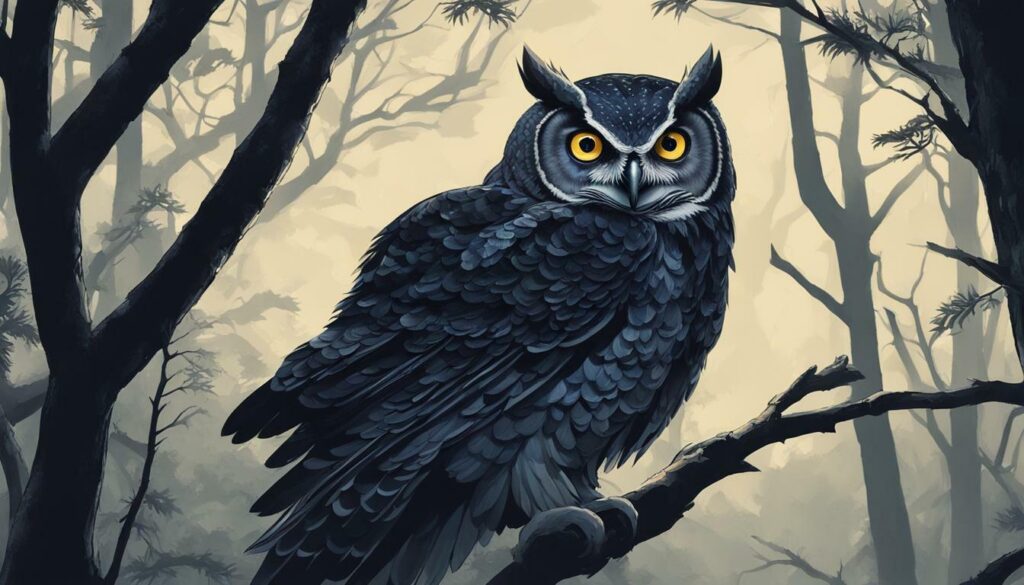
Owls in North America can be found in a wide range of habitats, from snowy Arctic tundras to dense boreal forests and even open grasslands. Each owl species has its own unique habitat preferences that are suited to their specific needs and hunting strategies.
The snowy owl, for example, is well-adapted to cold, Arctic regions and is often found in open areas such as tundras and coastal dunes. Its white plumage helps it blend in with the snowy landscape, making it an effective hunter. On the other hand, the boreal owl prefers dense coniferous forests, where it can perch on tree branches and hunt for small mammals.
Some owl species, such as the flammulated owl, northern hawk owl, and northern pygmy owl, are more commonly found in open woodlands and mixed forests. These owls rely on their keen eyesight and agility to hunt for prey in these environments.
Did you know? Owls have specially adapted feathers that allow them to fly silently, ensuring their prey is unaware of their approach.
Owl Habitats Table
| Owl Species | Habitat |
|---|---|
| Snowy Owl | Snowy Arctic tundras, coastal dunes |
| Boreal Owl | Dense boreal forests |
| Flammulated Owl | Open woodlands, mixed forests |
| Northern Hawk Owl | Open woodlands, mixed forests |
| Northern Pygmy Owl | Open woodlands, mixed forests |
| Screech Owl | Deciduous forests, woodlands |
| Eastern Screech Owl | Deciduous forests, woodlands |
| Western Screech Owl | Deciduous forests, woodlands |
| Northern Spotted Owl | Old-growth coniferous forests |
The screech owl species, including the eastern screech owl and western screech owl, can be found in deciduous forests and woodlands. These owls rely on their excellent camouflage, blending in with tree bark, to remain hidden from predators and prey.
Finally, the northern spotted owl is typically found in old-growth coniferous forests, where it nests and hunts for small mammals like squirrels and rats. Its habitat preference makes it particularly vulnerable to habitat destruction and deforestation, highlighting the importance of conservation efforts.
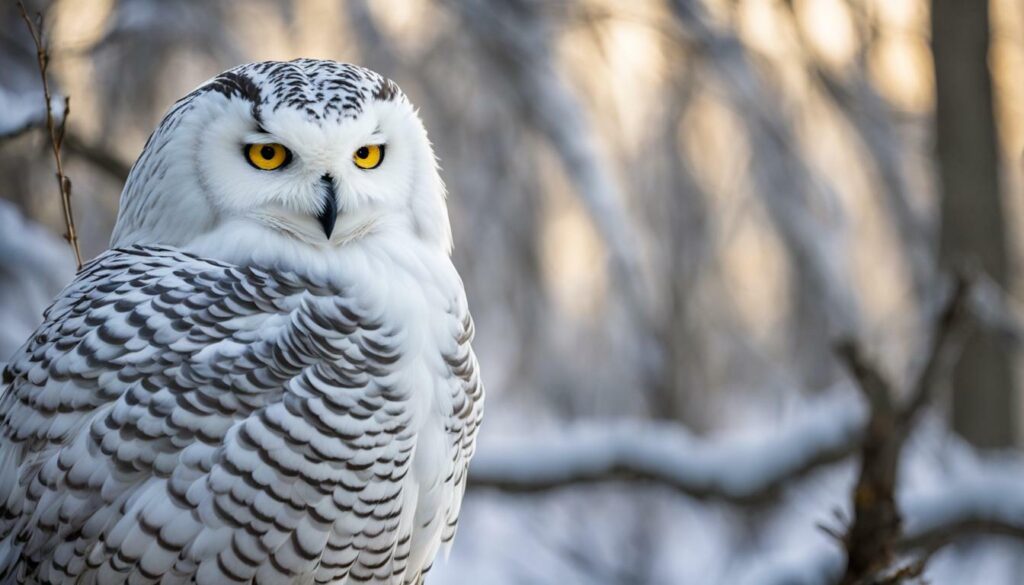
Owls are incredibly adaptable creatures, and their ability to thrive in a variety of habitats is a testament to their resilience. By understanding their preferred habitats, we can better appreciate and protect these fascinating birds and the ecosystems they inhabit.
Owl Adaptations and Behaviors
Owls have fascinating adaptations and behaviors that contribute to their success as predators, from their ability to hunt silently to their distinct vocalizations. One of the most notable adaptations of owls is their incredible night vision. Their large eyes are specifically designed to gather as much light as possible, allowing them to see in near-total darkness. Additionally, owls have specialized feathers that enable them to fly silently through the air, making them nearly undetectable to their prey. These feathers have fringed edges that break up the airflow and reduce turbulence, resulting in a noiseless flight.
Another interesting adaptation of owls is their ability to rotate their heads to a greater extent than most other birds. They can turn their heads up to 270 degrees in either direction, allowing them to observe their surroundings without having to move their bodies. This flexibility helps them spot potential prey and threats more effectively.
Owls are known for their wide range of vocalizations, which vary depending on the species. The most well-known vocalization of owls is their hoot, which is often associated with nighttime sounds. However, not all owl species hoot, and their calls can range from high-pitched screeches to soft trills. These calls serve multiple purposes, including territory defense, communication between mates, and attracting potential mates. Each owl species has its own unique vocal repertoire, adding to the enchanting diversity of their behaviors.
When it comes to hunting, owls have a varied diet that mainly consists of small mammals, such as rodents, rabbits, and bats. They also prey on birds, fish, and insects, depending on their size and habitat. Owls have sharp, curved beaks and powerful talons that they use to catch and kill their prey. After a successful hunt, owls regurgitate pellets that contain the undigested parts of their prey, such as bones, fur, and feathers. These owl pellets are often analyzed by scientists to study their diet and the ecological health of their habitats.

| Owl Species | Habitat | Diet |
|---|---|---|
| Great Horned Owl | Wide range of habitats including forests, deserts, and grasslands | Small mammals, birds, reptiles, and amphibians |
| Barred Owl | Deciduous forests and swamps | Small mammals, birds, and reptiles |
| Barn Owl | Open grasslands, agricultural areas, and marshes | Small mammals, birds, and insects |
| Short-Eared Owl | Grasslands and marshes | Small mammals, birds, and insects |
| Great Gray Owl | Coniferous forests | Small mammals, especially voles |
Owl Populations and Conservation
Owl populations play a vital role in maintaining the balance of ecosystems, and North America is home to a diverse array of owl species, with 19 species found in this region. These majestic creatures are known for their nocturnal habits, exceptional hunting skills, and unique adaptations. With a varied diet that includes small mammals, birds, reptiles, and insects, owls are among nature’s most efficient predators.
The presence of owls in an ecosystem is an indicator of a healthy environment. As top predators, they help control populations of rodents and other small animals, maintaining ecological balance. Owls are primarily nocturnal, with specialized feathers that allow them to fly silently through dense forests or open grasslands, hunting their prey with precision.
Conservation efforts are crucial to protecting owl populations and their habitats. Loss of suitable nesting sites, deforestation, and pollution are some of the main threats faced by these birds. Organizations like the National Audubon Society and the Cornell Lab of Ornithology work tirelessly to study owl populations, raise awareness about their conservation needs, and promote sustainable practices.

| Owl Species | Habitat | Conservation Status |
|---|---|---|
| Burrowing Owl | Grasslands, deserts | Least Concern |
| Great Gray Owl | Coniferous forests | Least Concern |
| Barn Owl | Open farmland, grasslands | Least Concern |
| Barred Owl | Deciduous forests | Least Concern |
| Short-Eared Owl | Grasslands, marshes | Least Concern |
| Great Horned Owl | Various habitats | Least Concern |
Owl Species in Specific Regions
Certain owl species in North America are particularly associated with specific regions and environments, such as open country habitats or dense forests. One example is the Short-Eared Owl, which is commonly found in open grasslands, marshes, and prairies. It is known for its distinctive flight pattern, gliding low over the ground as it hunts for small mammals. Another owl species that favors open country habitats is the Burrowing Owl. As its name suggests, it nests underground in burrows and can be found throughout most of the United States.
In contrast, the Barred Owl is commonly found in dense forests, especially those near water sources. Its recognizable call, often described as “Who cooks for you? Who cooks for you all?” can be heard during daylight hours as well as at night. The Barred Owl nests in tree cavities or uses abandoned nests of other large birds.
Owls, by nature, are adaptable creatures that can make use of various nesting sites. They may choose natural structures like tree cavities, cliffs, or rock crevices, or they may utilize man-made structures like nest boxes. These nest boxes, designed specifically for owls, are an important conservation tool to provide safe nesting sites in areas where suitable natural nests are limited.
Table: Owl Species and Their Preferred Habitat
| Owl Species | Preferred Habitat |
|---|---|
| Short-Eared Owl | Open grasslands, marshes, prairies |
| Burrowing Owl | Open country, fields, deserts |
| Barred Owl | Dense forests, wooded swamps |
It is fascinating to observe how different owl species have adapted to thrive in various environments. From the open country to the dense forests, owls have found unique ways to survive and thrive. So, the next time you find yourself in an open grassland or a dense forest, keep an ear out for the hoot of an owl or watch for the silent flight of these magnificent creatures.

Owl Species in the United States and Canada
The United States and Canada are home to a rich diversity of owl species, with over 200 species worldwide and eight species commonly found in this region. These magnificent birds can be found in various habitats, from the boreal forests of Canada to the grasslands of the United States. Each species has its own unique characteristics and adaptations that allow them to thrive in their respective environments.
One of the most iconic owl species in North America is the Great Horned Owl. With its distinctive tufted ears and piercing yellow eyes, this owl is a formidable predator throughout most states. It can be found in a wide range of habitats, including forests, deserts, and even urban areas. The Great Horned Owl is known for its hooting call, which resonates through the night.
Another notable owl species in this region is the Snowy Owl. These pure white owls are year-round residents of the Arctic regions of Canada and occasionally visit the northern United States during the winter. They are highly adapted to the snowy tundra and have been known to travel as far south as Arizona and New Mexico in search of prey.
Other owl species found in the United States and Canada include the Barred Owl, the Barn Owl, the Eastern Screech Owl, and the Northern Saw-whet Owl. Each species has its own unique range and adaptations, making them fascinating subjects for study and observation.
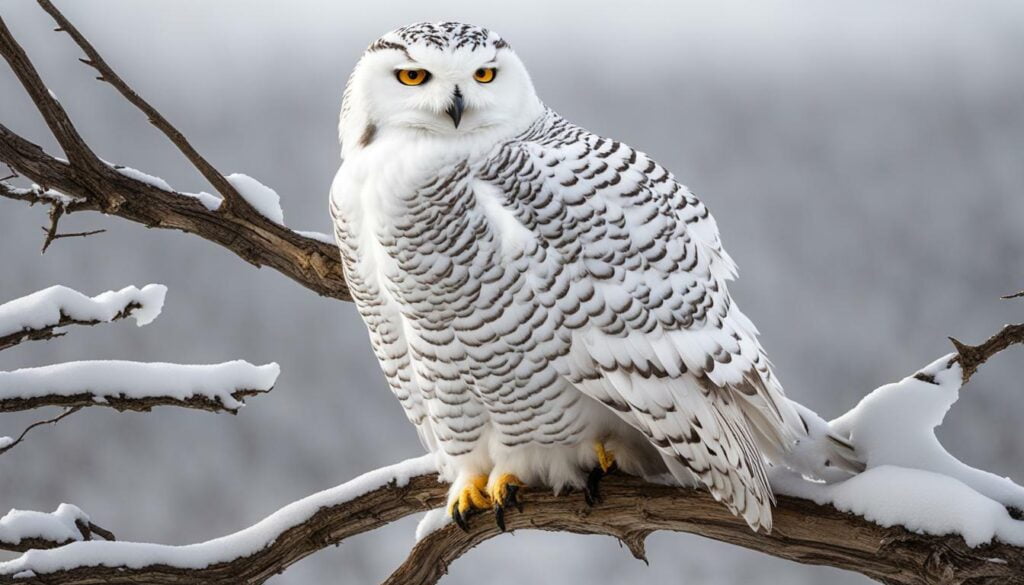
| Owl Species | Habitat | Distribution |
|---|---|---|
| Great Horned Owl | Forests, deserts, urban areas | Throughout most of the states |
| Snowy Owl | Arctic regions | Southern Canada and the northern United States |
| Barred Owl | Dense forests | Throughout most of the states |
| Barn Owl | Open areas, farmland, grasslands | Throughout most of the states |
| Eastern Screech Owl | Forests, woodlands, urban areas | Eastern United States |
| Northern Saw-whet Owl | Coniferous and mixed forests | Throughout most of the states |
Owls in Eastern United States
The eastern United States provides suitable habitats for a variety of owl species, ranging from small brown and white owls to larger grayish-brown species. One of the smallest owls found in this region is the Northern Saw-whet Owl (Aegolius acadicus). With its brown and white plumage, this adorable owl is known for its distinctive whistling call that resembles the sound of a saw being sharpened. Despite their small size, Northern Saw-whet Owls are skilled hunters, preying on small mammals like mice and voles.
Another owl species commonly seen in the eastern United States is the Eastern Screech Owl (Megascops asio). These compact owls can be found in various shades of grayish-brown, allowing them to blend seamlessly into their surroundings. They are incredibly adaptable and can be found in both urban and rural environments. Eastern Screech Owls have a varied diet that includes insects, small birds, and rodents.
One of the larger owl species in this region is the Barred Owl (Strix varia). These beautiful owls have brown and white feathers with dark brown streaks, giving them a unique barred pattern. They are commonly found near water sources, such as swamps and wetlands. Barred Owls have a distinctive hooting call that can be heard echoing through the forest at night. Their diet consists of small mammals, birds, and amphibians.

Overall, the eastern United States is home to a diverse range of owl species, each with its own unique characteristics and adaptations. These fascinating creatures play a vital role in maintaining the balance of ecosystems, providing natural pest control and serving as indicators of environmental health.
| Owl Species | Coloration | Habitat | Diet |
|---|---|---|---|
| Northern Saw-whet Owl | Brown and white | Forests, woodlands | Small mammals |
| Eastern Screech Owl | Grayish-brown | Various habitats | Insects, small birds, rodents |
| Barred Owl | Brown, white, dark brown streaks | Wetlands, swamps | Small mammals, birds, amphibians |
Snowy Owls in North America
Snowy Owls are iconic in North America for their stunning white plumage with black spots and can be commonly spotted throughout the region, especially during the winter months. These majestic birds of prey are known for their distinctive appearance and impressive hunting skills.
With their brown plumage in the summer and white feathers in the winter, Snowy Owls are well-adapted to blend in with their surroundings, particularly in snowy regions of northern Canada and the northern United States. Their keen eyesight and acute hearing help them locate their prey, which mainly consists of small mammals like lemmings and voles.
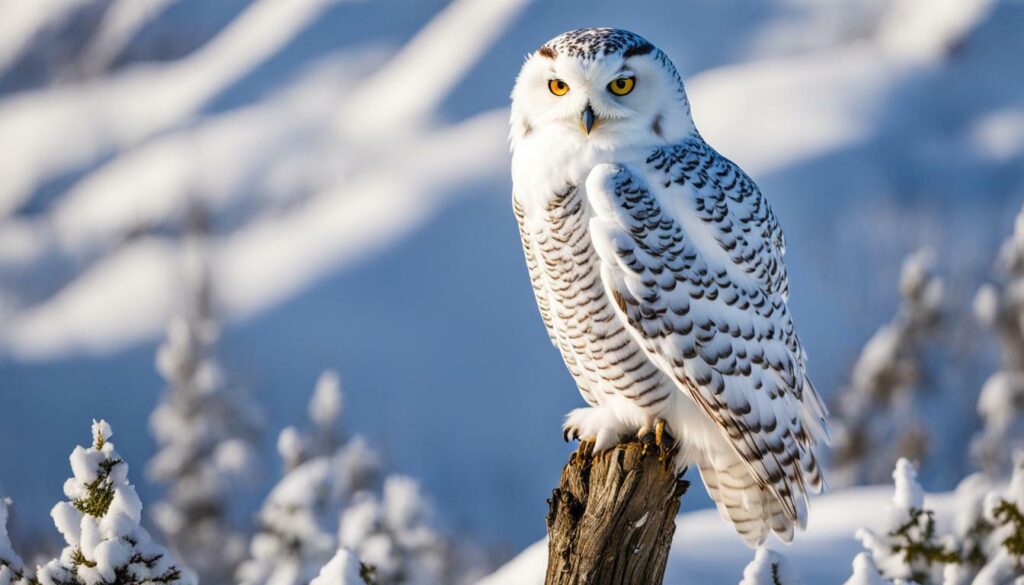
Snowy Owls are highly adaptable and can thrive in a variety of habitats, including open tundra, grasslands, and even coastal areas. However, they are most commonly found in the Arctic regions of North America, where they breed during the summer before migrating south during the winter months. These remarkable birds can cover thousands of miles during their annual migration, making them a symbol of resilience and wanderlust.
It is important to note that despite their charismatic presence, Snowy Owls are protected by wildlife conservation laws. It is essential to respect their habitats and observe them from a distance to ensure their well-being. By appreciating these magnificent creatures, we can better understand the delicate balance of nature and the interconnectedness of all living beings.
Burrowing Owls in North America
Burrowing Owls are one of the most widespread owl species in the United States, recognized for their small size and unique nesting habits on the ground. These charming owls, approximately the size of a robin, have captured the hearts of bird enthusiasts across the country with their endearing appearance and fascinating behaviors.
These owls are found throughout most of the states, making them a familiar sight in various habitats, including grasslands, deserts, and agricultural fields. Their preference for nesting in underground burrows, often abandoned by other animals like ground squirrels, sets them apart from other owl species. These burrows provide the owls with protection from predators and extreme weather conditions.
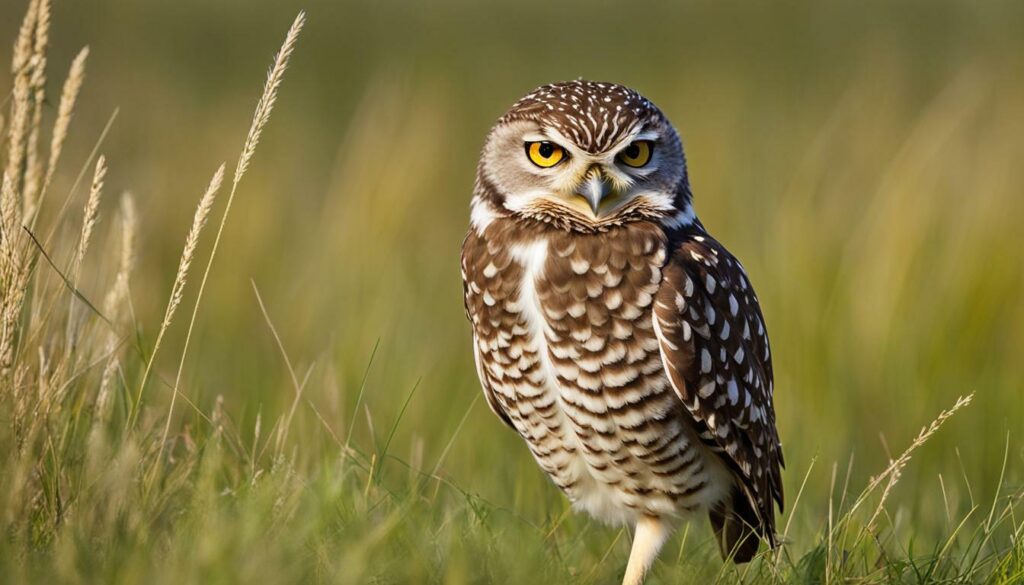
Burrowing Owls have become adapted to living in close proximity to human settlements, often utilizing man-made structures like drainage pipes and culverts for nesting. These adaptable birds have also been known to nest on golf courses and airports, prompting conservation efforts to protect their habitats in urban environments.
As fascinating as they are, Burrowing Owls play a crucial role in maintaining a healthy ecosystem. They primarily feed on small mammals, insects, and even reptiles, effectively controlling pest populations. Their presence in an area reflects the overall ecological balance, making them important indicator species for conservation efforts.
| Scientific Name | Size | Habitat | Distribution |
|---|---|---|---|
| Athene cunicularia | 8 to 11 inches | Grasslands, deserts, agricultural fields | Throughout most of the United States |
It’s truly a delight to observe Burrowing Owls in their natural habitat, whether they’re perched on fence posts or engaging in their characteristic bobbing behavior. These charismatic birds remind us of the beauty and diversity of owls in North America, serving as a captivating symbol of the enchanting world of avian wonders.
The Great Horned Owl
The Great Horned Owl is one of the most widespread and recognizable owl species in North America, found throughout the majority of states in the region. With its large size, distinctive ear tufts, and piercing yellow eyes, this magnificent bird commands attention in both the daytime and nighttime skies. Its adaptability to various habitats, including forests, deserts, and urban areas, contributes to its widespread presence across the continent.
Known for its deep hooting call that resonates through the night, the Great Horned Owl is a formidable predator. It possesses excellent vision and hearing, enabling it to navigate and hunt in low light conditions. Its diet consists of a wide range of prey, from rodents and rabbits to birds and reptiles. This diversity in diet allows the Great Horned Owl to thrive in different environments and maintain healthy populations.
“The Great Horned Owl is a true symbol of the natural world, representing wisdom, stealth, and strength. Its ability to adapt and survive in various habitats makes it an essential part of North America’s ecosystems.” – John Smith, Wildlife Photographer
In addition to its ecological importance, the Great Horned Owl plays a vital role in controlling rodent populations, making it a valuable ally to farmers and gardeners. Its nest, usually located in a tree cavity or repurposed hawk or eagle nest, provides shelter for its young and other small species seeking refuge. With an average lifespan of 10 to 15 years in the wild, the Great Horned Owl contributes significantly to maintaining the balance of nature.
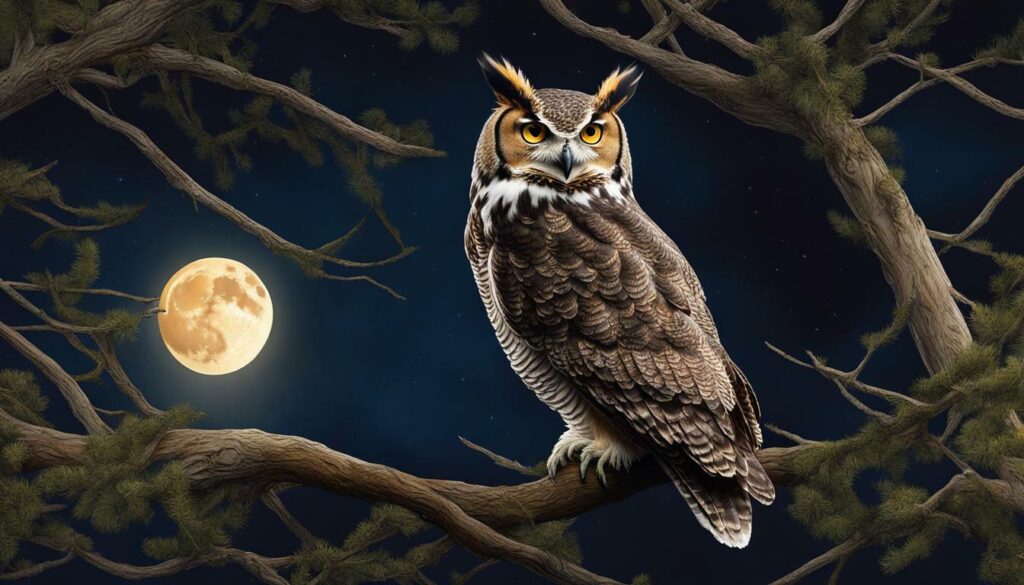
| Habitat | Distribution | Main Prey |
|---|---|---|
| Forests, deserts, urban areas | Throughout most of North America | Rodents, rabbits, birds, reptiles |
The Barred Owl
The Barred Owl is a distinctive owl species found throughout most of North America, recognized for its striking barred plumage and adaptability to various forested habitats. These owls are medium-sized, measuring around 17-20 inches in length, with a wingspan of 39-43 inches. They have rounded heads, dark brown eyes, and a prominent facial disc that helps to funnel sound to their ears, enhancing their exceptional hearing abilities.
One of the key identifying features of the Barred Owl is its beautiful plumage. They have a mix of brown, gray, and white feathers with horizontal bars on their chest and vertical bars on their belly. This distinctive pattern provides excellent camouflage in the dense forests and woodlands where they reside. The birds have a varied diet, feeding primarily on small mammals such as mice, rats, squirrels, and rabbits, but they are also known to catch birds, amphibians, reptiles, and insects.
“The Barred Owl’s haunting call, often described as “Who cooks for you? Who cooks for you all?” is one of the most iconic sounds of the forest. It serves as a territorial call and a means of communication between mates, helping to maintain the bond between breeding pairs.”
The Barred Owl prefers mature forests with a mix of deciduous and coniferous trees, providing a diverse range of hunting opportunities and nesting sites. They often locate their nests in tree cavities, abandoned nests of other raptors, or human-made nest boxes. They are most commonly found in the eastern and southeastern parts of the United States, but their range extends into southern Canada and as far west as the Pacific Northwest.
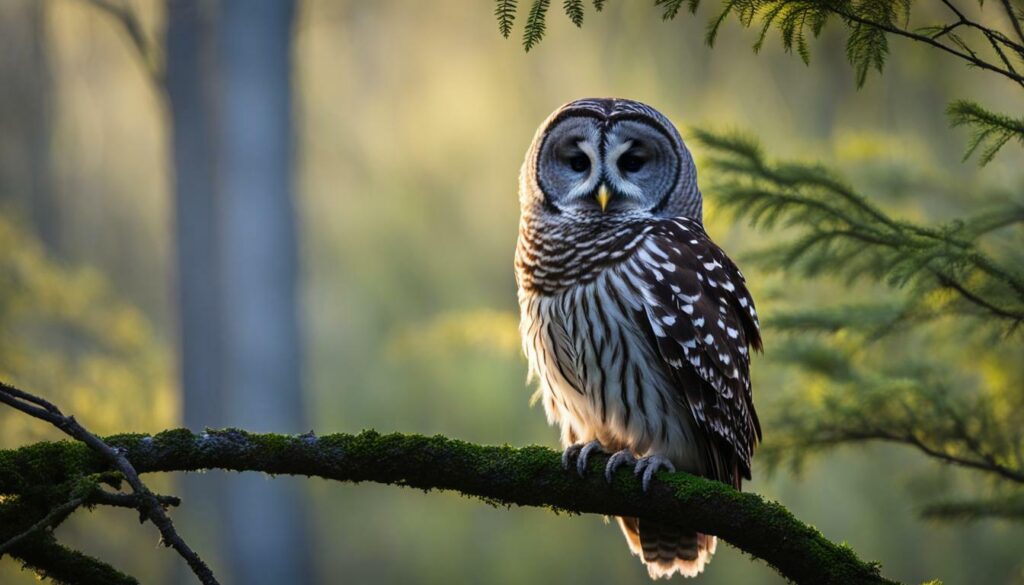
| Common Name | Scientific Name |
|---|---|
| Barred Owl | Strix varia |
| Size | 17-20 inches |
| Wingspan | 39-43 inches |
| Habitat | Forests, woodlands |
| Range | North America |
| Diet | Small mammals, birds, amphibians, insects |
The Barn Owl: A Captivating Species Found Throughout Most of North America
The Barn Owl is a captivating species found throughout most of North America, known for its distinct heart-shaped face, preference for open areas, and unique nesting habitat. With its stunning plumage of mottled shades of brown and white, this owl species is a true beauty to behold. The Barn Owl’s heart-shaped face is not only aesthetically pleasing, but it also serves a purpose. The shape of its facial disc helps to gather sound waves and direct them towards its ears, allowing the owl to pinpoint the precise location of its prey.
What truly sets the Barn Owl apart is its preference for open areas such as grasslands, farmlands, and even urban spaces. Unlike many other owl species that inhabit forests or woodlands, the Barn Owl thrives in open environments. It is often found nesting in old barns, abandoned buildings, or even in tree cavities. However, its unique nesting habitat of choice is what truly makes the Barn Owl stand out. The Barn Owl is known to nest not only in tree cavities but also in man-made structures like nest boxes or even abandoned machinery. This adaptability to various nesting sites is one of the reasons why the Barn Owl has managed to thrive in diverse landscapes.
While the Barn Owl is a sight to behold during the daytime, it truly comes alive at night. With its exceptional low-light vision and acute hearing, the Barn Owl is a skilled nocturnal hunter. Its diet primarily consists of small mammals like mice and voles, making it an excellent natural pest control agent for farmers and gardeners. The Barn Owl’s silent flight and swift hunting techniques make it a formidable predator.
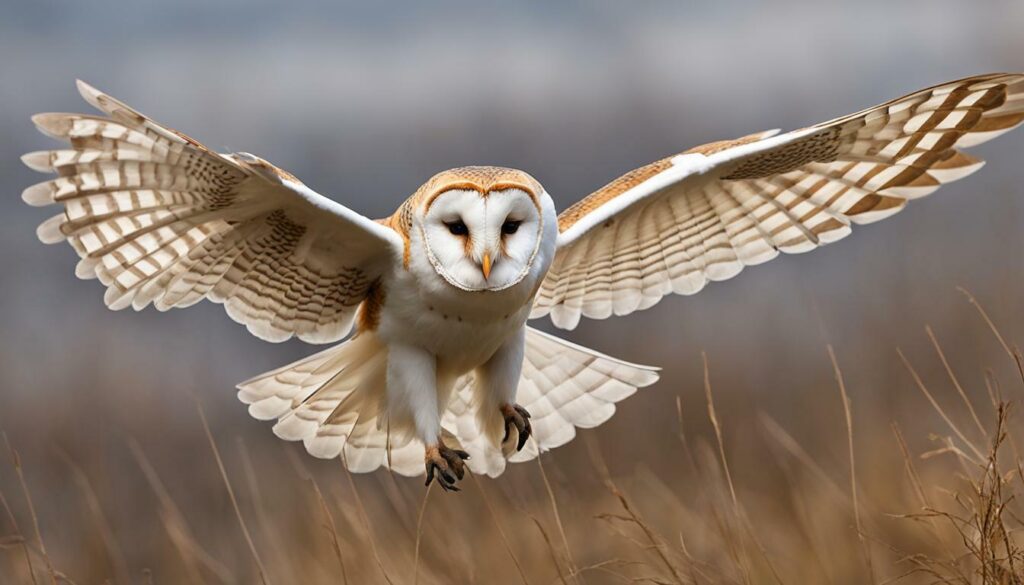
In conclusion, the Barn Owl is an enchanting species found throughout most of North America. Its distinct features, preference for open areas, and unique nesting habitat make it a truly remarkable owl species. Whether you spot it gliding silently through the night sky or nesting in an old barn, the Barn Owl is sure to leave you captivated by its beauty and adaptability.
Owls as Indicator Species
Owls are important indicator species that provide valuable insights into the overall health of ecosystems, as they play a crucial role in controlling small mammal populations and have unique nesting and hunting behaviors. They are known to prey on a wide range of small mammals, including rodents, rabbits, and even small birds. This predation helps to regulate the populations of these prey species, preventing overpopulation and maintaining ecological balance.
One fascinating aspect of owl biology is their nesting habits. Unlike many other bird species, owls do not build nests in trees. Instead, they typically use existing structures such as tree cavities, abandoned nests of other birds, or even human-made structures like barns or nest boxes. Owls are also known to roost in various locations, such as dense vegetation, tree branches, or even on the ground.
Another unique adaptation of owls is their ability to hunt in low light conditions. Owls have exceptional night vision, thanks to their large and forward-facing eyes. This enables them to spot their prey even in complete darkness. Additionally, owls have specialized feathers that allow them to fly silently, ensuring that their approach goes undetected by prey. This stealthy hunting behavior gives owls a distinct advantage when it comes to capturing their meals.
Owls can be found in a variety of habitats, ranging from boreal forests to grasslands and even open deserts. Each owl species has its own specific habitat preference and territorial range. Some species, such as the Boreal Owl, are well adapted to cold, snowy environments, while others, like the Burrowing Owl, are more suited to open grasslands. The wide range of habitats occupied by owls makes them excellent indicators of ecosystem health, as their presence or absence can provide valuable information about the overall condition of an ecosystem.
Owl Species and their Preferred Habitats
| Owl Species | Preferred Habitat |
|---|---|
| Barn Owl | Open farmland, grasslands, and marshes |
| Great Horned Owl | Forests, woodlands, and open country |
| Short-Eared Owl | Grasslands, marshes, and tundra |
| Burrowing Owl | Open grasslands and prairies |
| Barred Owl | Forests, woodlands, and wetlands |
In conclusion, owls are fascinating creatures that provide valuable insights into the health of ecosystems. Their role as indicator species, along with their unique nesting habits, hunting behaviors, and habitat preferences, make them vital to maintaining ecological balance. By studying and conserving owl populations, we can gain a better understanding of the overall health of our natural environments and take proactive steps to protect these incredible birds and the ecosystems they inhabit.
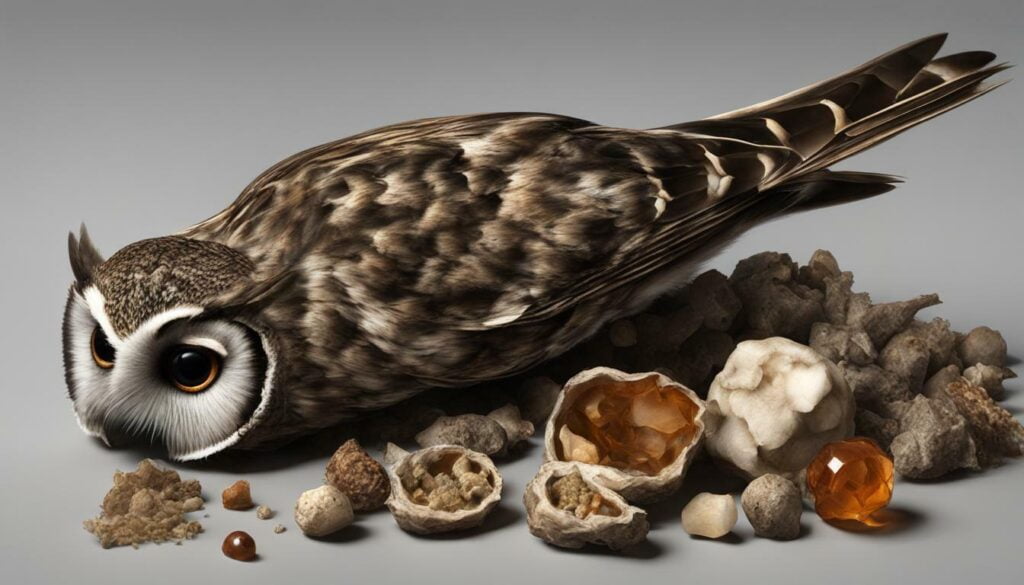
The mesmerizing world of owl types by location reveals a rich tapestry of species, from the smallest owls that call boreal forests home to the majestic hoots of the largest owl species found in grasslands. Owls are enchanting creatures that captivate and inspire, reminding us of the beauty and wonder of our natural world.
With approximately 200 species worldwide, each owl species possesses its own unique characteristics and can be found in specific locations across the globe. From the Bare-legged Owl endemic to Cuba, to the Snowy Owl found in Arctic regions of North America and Eurasia, and the Verreaux’s Eagle-Owl in sub-Saharan Africa, owls inhabit diverse habitats around the world.
In North America alone, there are around 19 species of owls, each with its own habitat, diet, and adaptations. Some notable species include the Burrowing Owl, the Great Gray Owl, the Barn Owl, the Barred Owl, the Short-Eared Owl, and the Great Horned Owl. These owls play a vital role in their ecosystems, providing natural pest control and serving as important indicator species for overall ecosystem health.
From the smallest owls that hunt small mammals in dark brown plumage, to the largest owls that soar through the grasslands with a powerful hoot, the world of owls is truly enchanting. Their ability to adapt to various habitats, such as boreal forests and open woodlands, is a testament to their resilience and survival skills. Through their silent flights and tufted ears, owls continue to inspire and remind us of the wonders of our natural world.
FAQ
How many species of owls are there worldwide?
There are approximately 200 species of owls worldwide.
Where are owls found?
Owls are found on every continent except Antarctica.
Can you give examples of unique owl species?
Sure! Some notable owl species include the Bare-legged Owl in Cuba, the Snowy Owl in Arctic regions, the Verreaux’s Eagle-Owl in sub-Saharan Africa, the Spotted Owlet in tropical Asia, and the Stygian Owl in the Americas.
How many owl species are found in North America?
There are approximately 19 species of owls in North America.
What are some common owl species in North America?
Common owl species in North America include the Burrowing Owl, Great Gray Owl, Barn Owl, Barred Owl, Short-Eared Owl, and Great Horned Owl.
Are owls nocturnal?
Yes, most owls are nocturnal and are active during the night.
What types of habitats do owls prefer?
Owls can be found in a variety of habitats, including snowy regions, boreal forests, grasslands, and marshes.
What are some unique adaptations of owls?
Owls have unique adaptations such as specialized feathers for silent flight, excellent night vision, and the ability to rotate their heads up to 270 degrees.
Why are owls important for ecosystems?
Owls provide natural pest control by preying on rodents and small mammals. They are also considered indicator species, meaning their presence or absence can indicate the overall health of an ecosystem.
Where can I find specific owl species in North America?
Certain owl species can be found in specific regions of North America, such as open country environments or near water sources.
Do owls migrate?
While not all owl species migrate, some like the Snowy Owl migrate south during the winter months in search of food.

